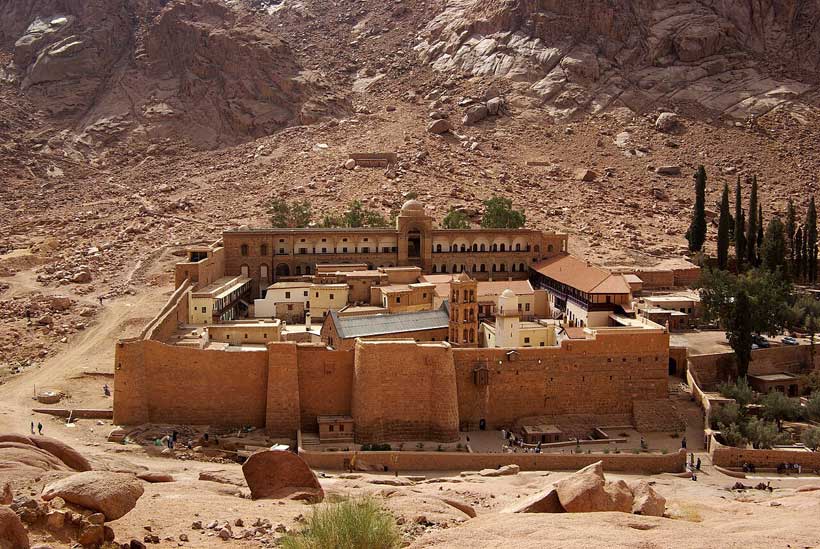St. Catherine’s Monastery at Sinai: A Power Game of Ecclesiastical Influence
The announcement of Archbishop Damianos’ resignation from St. Catherine’s Monastery in Sinai, after decades of leadership, has brought to light more than an internal monastic dispute. It has exposed a larger power struggle at the intersection of ecclesiastical diplomacy and international politics. The controversy surrounding the monastery, one of the most historic centers of Orthodoxy in the Middle East, has turned into a stage where rival patriarchates, foreign influence, and states assert their presence.
For many observers, Damianos’ departure was not simply the end of an era but the culmination of months of escalating tension between the Monastery, the Patriarchate of Jerusalem, and wider Orthodox dynamics influenced by Moscow.
Jerusalem’s contested claims
At the heart of the dispute lies the claim of the Patriarchate of Jerusalem over Sinai. In its official response, Jerusalem characterized Damianos’ statements as “anti-ecclesiastical” and questioned even the authorship of his lengthy announcement, suggesting manipulation by third parties. Ecclesiastical circles interpret this as a deliberate strategy of delegitimization, portraying the elderly Archbishop as incapable of independent action in order to undermine his authority.
Beyond rhetoric, Jerusalem has consistently sought to present Sinai as canonically dependent on its patriarchal throne, despite the historic sigillion of Patriarch Gabriel IV in 1782, which sealed the monastery’s autonomy. For Damianos and his supporters, such attempts constitute ecclesiastical encroachment and a direct violation of centuries-old canonical order.
Moscow’s shadow over Sinai
Damianos’ final announcement did not spare Moscow either. He accused the Russian Church of fueling division within Orthodoxy and exploiting internal fissures of the Sinai brotherhood. According to his account, networks and organizations aligned with Russian influence attempted to capitalize on the crisis, promoting narratives foreign to Orthodox theology and tradition.
For ecclesiastical diplomacy analysts, this dimension is crucial. It situates the Sinai crisis within the broader confrontation between Constantinople and Moscow over primacy in the Orthodox world, extending the arena of contestation from Ukraine to the deserts of Sinai. The monastery thus becomes more than a spiritual center; it is a geopolitical outpost in the struggle for influence.
Athens and Cairo as indispensable actors
The role of Greece has emerged as pivotal. Damianos repeatedly underlined that without the active involvement of Athens, the monastery would have faced existential threats. The recent law 5224/2025, combined with constitutional guarantees, was presented as a shield of protection for the monastery’s legal and institutional identity.
At the same time, Egypt remains a decisive interlocutor. The court decision of Ismailia in May 2025 that challenged elements of the monastery’s status placed the issue squarely within the Egyptian legal framework. Damianos himself acknowledged that any durable solution requires a tripartite understanding between Athens, Cairo, and the monastery’s leadership.
This triangular dynamic underscores that the future of Sinai cannot be separated from Greek–Egyptian relations, a strategic partnership already central in the Eastern Mediterranean. The monastery, therefore, becomes both a symbol and a test of bilateral trust.
Ecclesiastical diplomacy at a crossroads
The broader Orthodox world has also been drawn into the crisis. Several patriarchates expressed support for Sinai, including Constantinople, Bulgaria, Cyprus, and Serbia, while Jerusalem remained isolated in its claims. The silence of Moscow, combined with its indirect involvement, reinforced perceptions that Sinai has become a flashpoint in the Orthodox fragmentation that Russia has often been accused of exacerbating.
For Constantinople, Sinai’s autonomy is not negotiable. For Jerusalem, asserting control is both a matter of prestige and regional influence. For Moscow, exploiting divisions serves its wider strategy. And for Athens, safeguarding the monastery is part of its cultural diplomacy and historical responsibility toward the Eastern Christian heritage.
A power game with lasting implications
The resignation of Damianos closes a personal chapter but opens a much larger one. The crisis of Sinai illustrates how monastic autonomy, canonical tradition, and national diplomacy intersect. What appears as an ecclesiastical quarrel is, in fact, a power game of influence that involves patriarchates, states, and international alignments.
The outcome of the succession process, and whether a unified brotherhood can emerge, will determine not only the monastery’s internal cohesion but also the credibility of Greek–Egyptian partnership and the balance within Orthodoxy.
For analysts of ecclesiastical diplomacy, Sinai has become a microcosm of the wider struggle shaping the Orthodox world: the tension between autonomy and control, between local tradition and geopolitical leverage. The desert of Sinai, where Moses once received the Law, is today a battlefield of influence where spiritual heritage collides with political ambition.
